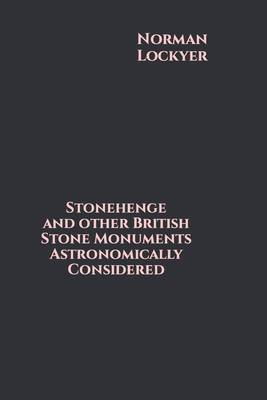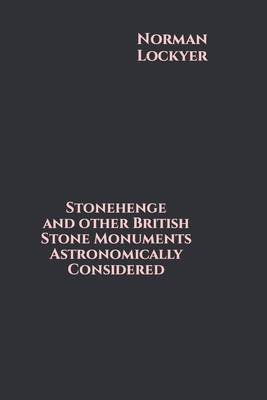
- Retrait gratuit dans votre magasin Club
- 7.000.000 titres dans notre catalogue
- Payer en toute sécurité
- Toujours un magasin près de chez vous
- Retrait gratuit dans votre magasin Club
- 7.000.0000 titres dans notre catalogue
- Payer en toute sécurité
- Toujours un magasin près de chez vous
Stonehenge and other British Stone Monuments Astronomically Considered
Norman Lockyer
16,95 €
+ 33 points
Format
Description
In continuation of my work on the astronomical uses of the Egyptian Temples, I have from time to time, when leisure has permitted, given attention to some of the stone circles and other stone monuments erected, as I believed, for similar uses in this country. In the book I published ten years ago, entitled "The Dawn of Astronomy," I gave a pretty full account of the principles and the methods of observation which enable us to trace the ideas which were in the minds of the ancient Egyptians when they set out the line of a temple they proposed to build. Numerous references to the ceremonial of laying the foundation-stones of temples exist, and we learn from the works of Chabas, Brugsch, Dümichen and others, that the foundation of an Egyptian temple was associated with a series of ceremonies which are repeatedly described with great minuteness. Amongst these ceremonies, one especially refers to the fixing of the temple-axis; it is called, technically, "the stretching of the cord," and is not only illustrated by inscriptions on the walls of the temples of Karnak, Denderah and Edfu - to mention the best-known cases - but is referred to elsewhere. During the ceremony the king proceeded to the site where the temple was to be built, accompanied mythically by the goddess Sesheta, who is styled "the mistress of the laying of the foundation-stone." Each was armed with a stake. The two stakes were connected by a cord. Next the cord was aligned towards the sun on some day of the year, or a star, as the case might be; when the alignment was perfect the two stakes were driven into the ground by means of a wooden mallet. One boundary wall parallel to the main axis of the temple was built along the line marked out. by this stretched cord. If the moment of the rising or setting of the sun or star were chosen, as we have every reason to believe was the case, seeing that all the early observations were made on the horizon, it is obvious that the light from the body towards which the temple was thus aligned would penetrate the axis of the temple from one end to the other in the original direction of the cord. We learn from Chabas that the Egyptian word which expresses. the idea of founding or laying the foundation-stone of a temple is Senti - a word which still exists in Coptic. But in the old language another word Pet-ser, which no longer remains in Coptic, has been traced. It has been established that pet means to stretch, and ser means cord, so that that part of the ceremonial which consisted in stretching a cord in the direction of a star was considered of so great an importance that it gave its name to the whole ceremonial. Dealing with the existing remains of Egyptian temples, it may be said that the most majestic among them was that of Amen-Rā at Karnak, dedicated to the Sun-God, and oriented, to catch the light, of the sun setting at the summer solstice, the time of the year at which the all-important rise of the Nile began. Although the sun is no longer worshipped in Egypt or Britain, sun-worship has not yet disappeared from the world. Professor Gowland has recently brought to notice a surviving form of sun-worship in Japan. I quote his statement: "There on the seashore at Fûta-mi-ga-ura (as will be seen in a copy of a print which I obtained at that ancient place) the orientation of the shrine of adoration is given by two gigantic rocks which rise from the sea as natural pillars. The sun as it rises over the mountains of the distant shore is observed between them, and the customary prayers and offerings made in that direction. It is, too, specially worthy of note that the point from which the sun is revered is marked by a structure of the form of a trilithon, but made of wood, placed immediately behind the altar.
Spécifications
Parties prenantes
- Auteur(s) :
- Editeur:
Contenu
- Nombre de pages :
- 192
- Langue:
- Anglais
- Collection :
- Tome:
- n° 67
Caractéristiques
- EAN:
- 9798607427436
- Date de parution :
- 02-02-20
- Format:
- Livre broché
- Format numérique:
- Trade paperback (VS)
- Dimensions :
- 152 mm x 229 mm
- Poids :
- 290 g

Les avis
Nous publions uniquement les avis qui respectent les conditions requises. Consultez nos conditions pour les avis.






